Text
10 Traits That Make a Character Secretly Dangerous
❥ Disarming Humor. They’re the life of the party. Everyone’s laughing. No one’s noticing how much they aren’tsaying.
❥ Laser-Sharp Observation. They see everything. Who’s nervous. Who’s lying. Who would be easiest to break. And they don’t miss.
❥ Unsettling Calm. Even in chaos, they stay still. Smiling. Thinking. Calculating.
❥ Weaponized Empathy. They know how to make people trust them. Because they know exactly what people want to hear.
❥ Compartmentalization. They can do something brutal, then eat lunch like nothing happened.
❥ Controlling Niceness. The kind of kindness that’s sharp-edged. You feel guilty for not loving them.
❥ Mirroring Behavior. They become whatever the person in front of them needs. It's not flattery. It’s survival—or manipulation.
❥ Selective Vulnerability. They know how to spill just enough pain to make you drop your guard.
❥ History of “Bad Luck”. Ex-friends, ex-lovers, ex-colleagues… they all left under “unfortunate” circumstances. But the pattern says otherwise.
❥ Unshakeable Confidence in Their Morality. They don’t think they’re the villain. That makes them scarier.
8K notes
·
View notes
Text
Rules
For general
Reposts, edits, and copying of any kind on any platform is not allowed.
You can ask me about the next post (i.e. "Can you write a post about How to create an effective villian", "Can you give me some mysterious prompts?", etc.), but please don't go over the limit.
I have the right to delete or ignore your asks and requests if I like it is disrespectful, does not follow the rules or I think I am not able to write it.
Thoughtful and helpful criticism is welcomed! I'm a bit vulnerable, so please be respectful and gentle.
Updating...
For fandom request: (Requests are OPEN)
I take requests for fluff, comfort, angst and yandere. I don't receive any requests related to NSFW (not my strengths)
I only take headcanon requests.
DO NOT request any work for any character that is not listed. Scroll down to see my list.
Each of my works have warnings listed before the work itself. Let me know if there is anything I missed!
Feel free to requests anything if my requests are open!
Updating...
Characters and fandoms I write for:
Genshin Impact: Aether, Albedo, Alhaitham, Arlecchino, Childe, Cyno, Diluc, Dottore, Kaveh, Kazuha, Lisa, Nahida, Pantalone, Raiden Ei (Raiden Shogun), Scaramouche, Tighnari, Venti, Zhongli.
Bungo Stray Dogs: all characters.
Jujutsu Kaisen: Satoru Gojo, Yuji Itadori, Megumi Fushiguro, Nobara Kugisaki, Maki Zen'in.
Hitman REBORN: all characters.
Fate Grand Order: all characters.
Twisted Wonderland: all characters.
Sultan's Game: all characters.
Criminal Minds: all characters.
Tokyo Revengers: all characters.
16 notes
·
View notes
Text
100 Dialogue Tags You Can Use Instead of “Said”
For the writers struggling to rid themselves of the classic ‘said’. Some are repeated in different categories since they fit multiple ones (but those are counted once so it adds up to 100 new words).
1. Neutral Tags
Straightforward and unobtrusive dialogue tags:
Added, Replied, Stated, Remarked, Responded, Observed, Acknowledged, Commented, Noted, Voiced, Expressed, Shared, Answered, Mentioned, Declared.
2. Questioning Tags
Curious, interrogative dialogue tags:
Asked, Queried, Wondered, Probed, Inquired, Requested, Pondered, Demanded, Challenged, Interjected, Investigated, Countered, Snapped, Pleaded, Insisted.
3. Emotive Tags
Emotional dialogue tags:
Exclaimed, Shouted, Sobbed, Whispered, Cried, Hissed, Gasped, Laughed, Screamed, Stammered, Wailed, Murmured, Snarled, Choked, Barked.
4. Descriptive Tags
Insightful, tonal dialogue tags:
Muttered, Mumbled, Yelled, Uttered, Roared, Bellowed, Drawled, Spoke, Shrieked, Boomed, Snapped, Groaned, Rasped, Purred, Croaked.
5. Action-Oriented Tags
Movement-based dialogue tags:
Announced, Admitted, Interrupted, Joked, Suggested, Offered, Explained, Repeated, Advised, Warned, Agreed, Confirmed, Ordered, Reassured, Stated.
6. Conflict Tags
Argumentative, defiant dialogue tags:
Argued, Snapped, Retorted, Rebuked, Disputed, Objected, Contested, Barked, Protested, Countered, Growled, Scoffed, Sneered, Challenged, Huffed.
7. Agreement Tags
Understanding, compliant dialogue tags:
Agreed, Assented, Nodded, Confirmed, Replied, Conceded, Acknowledged, Accepted, Affirmed, Yielded, Supported, Echoed, Consented, Promised, Concurred.
8. Disagreement Tags
Resistant, defiant dialogue tags:
Denied, Disagreed, Refused, Argued, Contradicted, Insisted, Protested, Objected, Rejected, Declined, Countered, Challenged, Snubbed, Dismissed, Rebuked.
9. Confused Tags
Hesitant, uncertain dialogue tags:
Stammered, Hesitated, Fumbled, Babbled, Mumbled, Faltered, Stumbled, Wondered, Pondered, Stuttered, Blurted, Doubted, Confessed, Vacillated.
10. Surprise Tags
Shock-inducing dialogue tags:
Gasped, Stunned, Exclaimed, Blurted, Wondered, Staggered, Marvelled, Breathed, Recoiled, Jumped, Yelped, Shrieked, Stammered.
Note: everyone is entitled to their own opinion. No I am NOT telling people to abandon said and use these. Yes I understand that said is often good enough, but sometimes you WANT to draw attention to how the character is speaking. If you think adding an action/movement to your dialogue is 'good enough' hate to break it to you but that ruins immersion much more than a casual 'mumbled'. And for the last time: this is just a resource list, CALM DOWN. Hope that covers all the annoyingly redundant replies :)
Looking For More Writing Tips And Tricks?
Check out the rest of Quillology with Haya; a blog dedicated to writing and publishing tips for authors!
Instagram Tiktok
31K notes
·
View notes
Text
a list of 100+ buildings to put in your fantasy town
academy
adventurer's guild
alchemist
apiary
apothecary
aquarium
armory
art gallery
bakery
bank
barber
barracks
bathhouse
blacksmith
boathouse
book store
bookbinder
botanical garden
brothel
butcher
carpenter
cartographer
casino
castle
cobbler
coffee shop
council chamber
court house
crypt for the noble family
dentist
distillery
docks
dovecot
dyer
embassy
farmer's market
fighting pit
fishmonger
fortune teller
gallows
gatehouse
general store
graveyard
greenhouses
guard post
guildhall
gymnasium
haberdashery
haunted house
hedge maze
herbalist
hospice
hospital
house for sale
inn
jail
jeweller
kindergarten
leatherworker
library
locksmith
mail courier
manor house
market
mayor's house
monastery
morgue
museum
music shop
observatory
orchard
orphanage
outhouse
paper maker
pawnshop
pet shop
potion shop
potter
printmaker
quest board
residence
restricted zone
sawmill
school
scribe
sewer entrance
sheriff's office
shrine
silversmith
spa
speakeasy
spice merchant
sports stadium
stables
street market
tailor
tannery
tavern
tax collector
tea house
temple
textile shop
theatre
thieves guild
thrift store
tinker's workshop
town crier post
town square
townhall
toy store
trinket shop
warehouse
watchtower
water mill
weaver
well
windmill
wishing well
wizard tower
114K notes
·
View notes
Text
Write a weak hero
Okay, first, what is weak? According to Oxford Dictionary, weak is lacking the power to perform physically demanding tasks; lacking physical strength and energy, or liable to break or give way under pressure; easily damaged.
That means, a weak hero is a character who isn't physically strong, mentally strong or even both.
So, how can we create a weak hero but do not make readers hate him/her? You will know after this post!
First, developing an effectively background
Unlike typical heroes who may have been born with incredible powers or had a dramatic origin story, the weak hero should come from a mundane background. They can be an ordinary person with nothing outstanding, a failure, etc. and suddenly have to shoulder the responsibility of "a hero" even though they don't want it.
Focus on their mundaneness and weakness. Describe the awkward situation where they are forced to become heroes. Why were they chosen to be heroes, when there are others who are more talented and powerful? What were the circumstances under which this happened? Make it as clear as possible.
Don't forget to describe their thoughts, feelings, and reactions. In their backstory, highlight times when the weak hero tried to be heroic or take on challenges, only to fall flat on their face. Was there a specific incident that shattered their self-esteem? Do they come from a family or environment that was overly critical? These past embarrassments and disappointments can inform their current self-doubts.
Use flashbacks strategically. Intersperse key backstory moments throughout the narrative to gradually reveal the hero's history and motivations, rather than dumping it all at once. This will help the reader better understand the character's journey and the reasons behind their reluctance to embrace the role of a hero.

Second, emphasizing their weakness
Focus on their mundane, everyday struggles. Rather than epic battles, the weak hero's conflicts should revolve around things like asking neighbors for help or failing to complete simple tasks.
You can also contrast them with stronger, more capable heroes. Have the weak hero regularly get overshadowed or overlooked by the more impressive feats of other characters.
The weak hero's ineptitude and frustrations can be a great source of comedy. So don't be afraid to poke fun at their failings :).

Third, slowly build towards small victories
If you want your weak hero to be liked by the readers, never let them be weak all the time. Drop subtle hints in the backstory that suggest the hero has untapped potential or unique talents that could one day be leveraged in unexpected ways, even if they don't realize it themselves.
Focus on the why. What made them become strong, or strive to become stronger? Is it a long-term motivation or a temporary one? Are they doing it for themselves or others? What will they do to overcome their weaknesses? Over time, the weak hero can learn to leverage their "useless" powers in clever ways and gain a little more confidence, even if they never become a heavy hitter.
And, remember to highlight their determination. Despite their shortcomings, the weak hero should possess an underlying stubbornness and refusal to give up. Showcase moments in their past where they persevered even when success seemed impossible.

Fourth, crafting challenges
When crafting challenges for a weak hero, you need to focus on obstacles that play to their specific limitations and insecurities. Here are some types of challenges a weak hero might face:
Outmatched in combat
The weak hero tries to take on a powerful villain, only to be easily overpowered by the villain's superior strength, speed, or abilities.
They get into a fight they can't win and have to rely on their wits or dumb luck to escape unscathed.
Inability to complete basic tasks
The weak hero struggles with simple everyday activities like opening a jar, fixing a leaky faucet, or assembling furniture.
These mundane challenges become major roadblocks that highlight their incompetence.
Social humiliation
The weak hero tries to interact with others, only to say the wrong thing and embarrass themselves.
They may attempt to flirt, negotiate, or simply make small talk, but end up flustered and socially awkward.
Lack of confidence
The weak hero doubts their abilities and has a hard time believing they can accomplish anything meaningful.
They may shrink away from opportunities to be heroic, worried they'll just mess things up.
Overbearing comparisons to stronger heroes
The weak hero is constantly overshadowed by the exploits of more powerful heroes, making them feel inadequate.
They may try to emulate the other heroes' successes, only to fail miserably.
Underestimation by villains
The villains dismiss the weak hero as harmless and ignore them, allowing the hero to stumble into accidentally foiling the villain's plans.
The villains may even make the mistake of toying with the weak hero, giving the hero a chance to catch them off guard.
The key is to create challenges that force the weak hero to rely on their limited abilities in creative ways. Gradually building their confidence through small wins can be a rewarding character arc.

Fifth, supportive relationships
The weak hero likely has friends, family members, or mentors who believe in them, even if the hero themselves does not. By including a support system of characters who see the weak hero's hidden potential, the narrative can strike a balance between the hero's self-doubt and the encouragement of those around them. These supporting characters can provide a counterpoint to the hero's negative self-perception, offering validation and pushing them to exceed their own expectations.
The interactions between the weak hero and their cheerleaders can also be a source of character development and emotional growth. As the hero gains confidence and finds ways to leverage their unique talents, the relationships with these supportive figures can evolve, deepening the overall narrative.
Supportive relationships can be of many types, but the most effective are:
A mentor figure who sees the hero's hidden strengths and pushes them to overcome their limitations.
A loyal friend who constantly encourages the hero and refuses to give up on them.
A capable sidekick or partner who can cover for the hero's weaknesses in battle.
A tech-savvy ally who develops gadgets or abilities to enhance the hero's limited powers.
A family member who provides unconditional love and acceptance, even when the hero doubts themselves.
A romantic interest who sees the hero's inner strength and brings out their best self.
A rival or adversary who recognizes the hero's true talents, forcing them to confront their own insecurities.
A renowned hero or role model who inspires the weak hero to strive for greatness, even if they don't believe they can achieve it.

It is not easy to create a weak hero. Crafting a compelling weak hero requires carefully balancing their flaws and insecurities with moments of growth and determination. You must find ways to make the character relatable and likable, despite their shortcomings, by highlighting their underlying potential and the support system that believes in them.
Hope you enjoy this. If you have any questions about writing, inbox me. I will answer as best as I can.
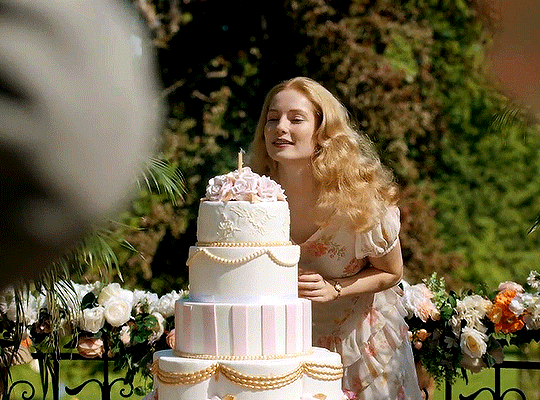
#writerscommunity#writers#writers on tumblr#writer things#writersociety#writblr#on writing#creative writing#writing#writeblr#writer#write#writings#writers and poets#writers block#ao3 writer#amwriting#writer problems#writer stuff#writer community#writer on tumblr#women writers#female writers#writers life#writing community#writing stuff#writing a book#writing prompt#writing advice#writing inspiration
596 notes
·
View notes
Text
EVERYONE SHOULD READ THIS!
Toxins, Venom, and Poisons in Historical Western Medicine: How Are We Not Extinct From Doing Some Of This To Ourselves?
This piece is an involuntary piece inspired by @writing-with-sophia's awesome post "Poison list", which is an accurate and succinct list of commonly known (and ancient!) poisons, venoms, and toxins that have been and were used for causing poisoning in ancient and recent history. I wanted to write this because what struck me by their post crossing my dash was, the sheer number of poisons listed that were - and even still are - used as mainstays for healthcare around the world throughout the ages!
OBLIGATORY DON'T BE A DUMBASS PSA: If you're planning on incorporating these poisons into your HISTORICAL-era writing, it's also important to remember that many of them were used for medicinal purposes at one time, too, and it's great you're interested in learning about the subject! And also, you shouldn't try ANY of these! I will not tell you how to do it at home if you DM me, so don't! You are not appropriately trained to do it! You will harm or kill yourself and possibly your loved ones if you fuck around with any of these and it will be 100% your fault and you absolutely should feel bad bout it! I've seen some of you idiots believe 4chan posts about making home-grown crystals using recipes for actual mustard gas and seen you being wheeled into the ER on the news! I will not feel bad if you get yourself hurt if you screw around with any of these plants, elements, or animals!
Resource blog plugs and PSA over, now for the Hilariously Poisonous Medicines:
If you're writing something that's meant to take place prior to the advent of our more modern understanding of poisons, venoms, and toxins, factoring in "this is toxic to me NOW, but what about 500 years ago?" can add a lot of opportunities for interesting plot elements to your story.
These can include someone accidentally poisoning themselves with a toxic drug or substance that wouldn't have killed them if they'd handled it properly - like tansy? Grows all over the place in Europe and England? That'll kill you if you harvest it too late in the season, but it's good for intestinal parasites when it's harvested early in the year and processed right.
Did the lady's maid really kill her mistress with belladonna? Or was she trying to secretly help her mistress get rid of an unwanted pregnancy?
The protagonist's children can't survive to make it to weaning age! Is the wetnurse a poisoner, or does the milkman hide that he sells sour milk by pouring Borax into it so no one could taste it and has no idea he's killing his clients' babies?
Nuance and cultural mores regarding historical views about poisons and toxins can make writing even more fun, dynamic, and interesting! Explore 'em!
Just... please don't try any of this crap yourself. You will poison yourself, it will hurt, you will die, and you will hurt the entire time you're dying. Using OP's master list alone, here's the flip side of these lethal beasts through the eyes of our distant ancestors who believed illness was caused by "vapors", "bad air", and "imbalanced humors":
Hemlock:
Used across multiple different cultures in history. When properly administered to treat a disease, poison hemlock was used to treat asthma, whooping cough, bronchitis, joint/bone pain, muscle cramps, and insomnia. Hemlock was most often used as a sedative and antispasmodic.
Arsenic:
Arsenic is a heavy metal, and so has been used in everything from making specialty dyes for wallpapers (Scheele's green is the most infamous arsenic-based paint; Queen Victoria once had a guestroom in her palace redone with Scheele's green wallpaper. The first dignitary to stay there had to be carried out and taken to emergency care after breathing astronomical amounts of arsenic dust from the wallpaper's paint), to medicine. Arsenic was especially commonly used in history to treat skin ailments ranging from acne, to psoriasis, to syphilis sores. It was also sometimes prescribed for menstrual cramps, upset stomachs, colic, and arthritis, among many, many other things.
Cyanide:
Uh... I have literally never found any evidence of cyanide in medicine, outside of its use in modern medicine as part of certain chemical lab tests for measuring urine ketone bodies that involve no contact with a patient whatsoever. Cyanide literally works in less than a few seconds to render your entire body incapable of absorbing OR using oxygen in your lungs or already existing in your blood. Cyanide is really only good at making things that breathe not breathe anymore.
Nightshade:
There are a lot of different "nightshades", so being specific is essential here. Potatoes are nightshades. Tomatoes are nightshades. Calling anything a "nightshade" does not inherently mean it's lethally toxic. Belladonna is probably the most notorious of the "deadly" nightshades, but to this day, is still used medicinally, and would actually be seen as a health and cosmetic mainstay in historical fiction, especially if your setting is in Italy!
Belladonna is an Italian portmanteau for "beautiful woman", because tinctures (water-based drops) of belladonna were commonly used by Italian women as eyedrops to dilate their eyes and appear more attractive, aroused, and desirable. Today, belladonna's eye-dilating effects are still used by optometrists to dilate the pupils! Belladonna has been, and still sometimes is used as an NSAID, general painkiller, motion sickness treatment, asthma medication, and even as a treatment for IBS.
Ricin:
As OP said, Ricin is derived from the toxin found in Castor Beans, and is surprisingly new as an official "the only reason this is made is to make someone dead" poison. Not only is ricin a popular "nobody would think to test for this!" choice in mystery/thriller writing, but it has been used for political assassinations in real life before. Georgi Markov, a Bulgarian anti-Communist dissenter and writer, was killed in 1978 with a 1.7mm diameter ricin-coated pellet shot into his thigh muscle by an unidentified assailant using a modified umbrella as a gun. He died 4 days later.
Historically, castor OIL has been used for medicinal purposes, especially for treating constipation, inducing labor in pregnancy, and as a topical skin moisturizer. If you've ever watched the opening scene in Disney's "Peter Pan", when the childrens' mother is trying to give them a spoonful of medicine each, she's actually giving them castor oil! Castor oil tastes really bad (so much so that flavorings like cinnamon were often added to try to muffle the taste), so the childrens' reluctance and disgust at their mom making them take their medicine is very realistic for the era the movie came out in!
Strychnine:
Another lethal poison that started life as a medicine/food additive. Strychnine is no longer used medicinally at all today, but historically, it was used to stimulate the heart, treat bladder and bowel incontinence, and limb palsy. Strychnine is a deadly-powerful muscle stimulant that, as a poison, causes horrifyingly painful full-body strictures (spasms) and destroys the cardiovascular system. (Fun fact: Strychnine and hydrochloric acid were historically mixed into cheap vodka to make knock-off gin, especially during the Georgian Era in England if the brewer didn't have or couldn't afford juniper berries!)
Snake Venom:
Seriously, do your research before you write an actual, real snake species using venom they don't produce! The Big 3 Forms Of Snake Venom are: Hemotoxic, Neurotoxic, and Cytotoxic. Specific snake species exclusively generate the same kind of venom (so a hemotoxic snake will ALWAYS produce baby snakes that also make hemotoxic venom). Aristotle himself wrote in 380 BC that certain snake venoms could be applied for treating fevers, smallpox, and leprosy, and there is even some evidence in the historical record prior to the 1800s that different cultures have experimented throughout the eons with using venom for converting into antivenom, but I've never found a source citing anyone making a successful form of antivenom until around the 1850s.
Digitalis:
OP really nailed the important thing about Digitalis, and that is it's cardiac benefits for certain people - particularly for treating congestive heart failure. Vincent van Gogh was actually prescribed epilepsy medication that likely contained Digitalis, aka Foxglove, and there are some prevailing theories about van Gogh's love of bright yellow paint as being either caused or exacerbated by the symptoms associated with digitalis use, which can cause an attraction to and increased visual sensitivity to the color yellow. In several portraits, including one of his own psychiatrist, van Gogh shows subjects presented alongside foxglove flowers. Digitalis is absolutely lethal if consumed or taken without expert guidance, however, because it's the mother ingredient of Digoxin. Digoxin isn't used as frequently as it used to be a few decades ago, but it's still used and prescribed today for certain forms of heart failure and heart disease. Digoxin was also, at one time, was also sometimes used to induce chemical abortions.
Lead:
Dear god, lead. Not only is it so slow to kill you that you'll think that the only way to manage your symptoms is with more lead, but lead poisoning can be a life-long crisis for a person who is regularly exposed to it. Humans have used lead for everything from plumbing, to paint, to our cutlery, to cosmetics, to medicine. While yes, it is very possible to ingest enough lead in a single sitting to die within hours or days, most sufferers of lead poisoning experience it for years or decades before the symptoms become obvious. Some archaeologists believe that the Romans used lead cutlery because lead has a unique reaction when we lick it: when you have lead coating your tongue, it makes EVERYTHING you eat suddenly taste 10x better. I learned this myself from going target-shooting with my mom at a gun rage as a teenager, inhaled gunsmoke (which contains lead), and went for lunch immediately after. Even though I was just eating a $5 meal from In-N-Out, my burger tasted so good I thought I was gonna have to change my pants. When I asked the rangemaster at the target place about it later, he literally said, "Oh yeah, lead makes the worst cooking taste like heaven."
The ancient Romans ate a lot of rotten, spoiled, and sour food, and so lead would've made it easier to eat it back then. But the neurological effects of lead poisoning are nightmarish. It's suspected that, in America, the #1 reason we had so many active serial killers in the country from the 1940s-2000s was because of leaded gasoline. Ever since leaded gasoline was banned? Serial and random violent crime rates have dramatically gone down, especially in metropolitan cities. Ancient Rome, too, gradually became an increasingly violent city as its population went up and its reliance on lead did. We're only just now starting to figure out how toxic lead actually is, so go nuts with using it as a plot element regarding subjects like "Why Are You Like This?"
Mercury:
Mercury is also known as quicksilver, because in spite of being a heavy metal, the temperature at which it melts into a liquid is very, very low compared to most other metals. The first Emperor of China, Qin Shi Huang, was rumored to be so obsessed with the notion of immortality that he would send his doctors on doomed voyages around the world searching for a legendary substance that would, indeed, make him immortal. Legend has it that some doctors who were tasked with the job found out about the last guys, and produced mercury before Emperor Qin Shi Huang and cried, "Here it is! I got it!" so they wouldn't end up doomed to drown at sea. Qin Shi Huang became so obsessed with ingesting and medicating himself with mercury that, when his legendary tomb was being constructed, he had a small-yet-accurate-to-scale map of China+the known world about the size of a football field with every body of water full of fountains of running mercury in his burial chamber. His tomb was rediscovered in the last couple of decades after archaeologists found suspiciously high levels of mercury in the soil on top of a "hill" that had been sitting in the countryside untouched for thousands of years. It turned out to be Qin Shi Huang's long-lost tomb.
Since those days, mercury has closely been associated in early medicine as a sort of cure-all, since it literally kills anything it touches (including people). Captain Blackbeard himself, the most notorious pirate in Western history (Western specifically; google who Zheng Yi Sao was), was known or widely believed to be a syphilis sufferer, and desperately sought infusions of mercury from ships he'd capture (and the doctors onboard) to treat it, believing like everyone did that mercury could cure syphilis. It can't. They just didn't understand back then that syphilis starts off surface-level, and then eats your brain years after the initial infection.
Aconite:
Again, ridiculously toxic outside of specific medicinal applications that still aren't safe today! Aconite, or wolfsbane, has historically been used as a heart sedative (for slowing the heart), diuretic, painkiller, and even used to induce sweating. Evidence of wolfsbane being used for medicinal purposes has been spotted here and there over thousands of years throughout the Greek, Roman, and Byzantine Empires, but its original use came about in Ancient Greece for hunting and culling wolves by poisoning bait-food with it. That form of hunting died out long before the European Middle Ages, but the name "wolfsbane" stuck. Mostly because in the Middle Ages, a lot of people believed werewolves were a huge problem, and kept wolfsbane handy to deter said werewolves.
Thallium:
Today, thallium is mostly used in the production of camera and eyeglass lenses. Before its toxicity was known about, it wasn't strange to hear of thallium being used topically to treat fungal infections like ringworm. Thallium was also sporadically used in treating typhus and tuberculosis, along with a wide array of sexually transmitted diseases.
This list doesn't even touch the tip of the toxic iceberg when it comes to the sheer quantity of hilariously dangerous toxins people have, or still continue, to use for medicinal purposes! In a Victorian-era English London middle-class townhouse setting alone, there were dozens and dozens of ways to poison or otherwise harm yourself just by going about your daily life. So, if you've got a period piece you're working on, or are just bored, you can pick an exact date and time in our history and learn just how terrifyingly comfortable our ancestors were with upsettingly dangerous substances and home remedies. You can also watch a massive docuseries, called "Hidden Killers" and hosted by historian Suzannah Lipscomb, among other historians and archaeologists, which deep-dives into the hidden and unknown dangers of living in eras from Tudor-Era England, to the Post-WWII Reconstruction Age.
As a final note: I am NOT bashing Chinese or Eastern medicinal practices here, and in fact deliberately have gone out of my way to not include any references toward culturally-sanctioned medicinal practices in Eastern and Southeastern Asia. This post is specifically related to the history of WESTERN medicines and their associated history. I am not, nor have I ever been, a doctor of any traditional Eastern medicinal practices, and do not pretend to know better. Sinophobes are unwelcome in my blog space.
#poison#long post#very long post#really long post#toxins#sinophobes dni#writing-with-sofia#historical medicine#writing reference#creative writing#actually my name is sophia but it's okay#writeblr#writers on tumblr#writing#writers life#writerscommunity#writers and poets#female writers#writer stuff#ao3 writer
124 notes
·
View notes
Text
Medieval Names for male
Alaric: German for "ruler of all."
Aldous: Italian and German for "old, wealthy."
Archibald: German for "genuine, bold, brave."
Arne: Old Norse for "eagle."
Arthur: Celtic for "bear; strong man.""
Bahram: Persian for "victorious."
Bard: Gaelic for "poet" or "singer."
Bartholomew: Hebrew for "son of furrow” or "son of Ptolemy."
Benedict: Latin for "blessed."
Bertram: German and French for "bright raven."
Björn: German and Scandinavian for "bold as a bear."
Burchard: English for "strong as a castle."
Cassian: Latin for "vain."
Cathasach: Gaelic for "brave."
Charibert: German for "glorious warrior."
Conrad: Old German for "brave counsel."
Crispin: Latin for "curly."
Cyprian: Greek origin name that means "man of Cyprus."
Daegal: An Anglo-Saxon name with Scandinavian roots that means "dweller by the dark stream."
Drogo: Old German name for "to bear" or "to carry."
Drustan: Believed to be derived from the Celtic and Gaelic word "drest" which means "riot."
Dustin: Old English for "dark stone" and German for "valiant fighter." It also means Thor’s stone.
Elric: English for "wise ruler."

#writerscommunity#writer things#writers#writeblr#on writing#writblr#writers on tumblr#creative writing#writing#writersociety#write#writings#writers and poets#writer#women writers#ao3 writer#amwriting#writers community#writing community#writers life#writers block#female writers#writer stuff#writer problems#fanfiction writer#fanfic writer#writer community#writer on tumblr#writers of tumblr#writers on ao3
227 notes
·
View notes
Text
Poison list (2)
Hello, it's me again! After some feedback on my previous potion list post, I decided to research a little more about potions and come up with this post. I hope everyone will like it!
1. Poison Ivy

I think anyone who has watched Batman will know the female supervillain Poison Ivy. I thought it was a name she came up with until I found the Poison Ivy plant online, lol.
Eastern poison ivy is typically a hairy, ropelike vine with three shiny green leaves budding from one small stem. The leaves may be red in the fall.
Western poison ivy is typically a low shrub with three leaves. In the East, Midwest, and South, it grows as a vine.
It may have yellow or green flowers and white to green-yellow or amber berries.
It has an oily sap in its leaves called urushiol. This causes an allergic reaction that can make your skin red, swollen, and itchy.
2. Poison Oak

It is typically, a shrub with leaves of three, like poison ivy. The sun-facing side of the leaf has tiny hairs on it and is a darker shade of green than the ground-facing side.
Pacific poison oak may be vine-like.
Though it grows all over the country, it’s more common in the West.
It could be hours or days before your skin reacts to the plant sap (urushiol). And your rash may eventually turn bumpy and form blisters that ooze.
3. White Snakeroot
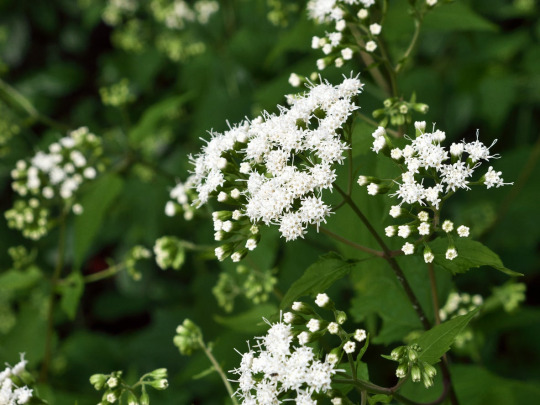
A North American herb with flat-topped clusters of small white flowers and contains a toxic alcohol known as trematol.
Generally found in woods and along streams. It is not often found on open prairies because it does not do well in full sunlight. The plant will grow 1 to 3 feet in height and will have thin smooth leaves with toothed margins.
The poisonous effects in livestock usually result from direct consumption of the white snakeroot plants. In humans, poisoning can be caused by consumption of dairy products from cows that have eaten white snakeroot.
4. Rosary Pea

Also called jequirity beans, these piously-named seeds contain abrin, an extremely deadly ribosome-inhibiting protein.
Rosary peas are native to tropical areas and are often used in jewelry and prayer rosaries. While the seeds are not poisonous if intact, seeds that are scratched, broken, or chewed can be lethal.
It only takes 3 micrograms of abrin to kill an adult, less than the amount of poison in one seed. It is said that numerous jewelry makers have been made ill or died after accidentally pricking their fingers while working with the seeds.
Abrin in rosary pea prevents protein synthesis within cells and can cause organ failure within four days.
5. Foxglove

Its bell-shaped flowers are often bright purple but can be white, yellow, or pink. It blooms in the spring. It also has a fruit with lots of seeds, which kids sometimes eat.
All parts of the flower are poisonous and can slow or disrupt your heart.
In fact, digitalis (a heart medicine) is derived from this plant. When formulated into a medication with a controlled dosage, digitalis is valuable in treating heart failure. It helps a weakened heart pump harder.
People who eat any part of the plant or make tea from the leaves are, in essence, taking an unregulated dose of heart medicine. This can cause the heart rate to slow down or become irregular. Both can be dangerous and life threatening.
6. Mistletoe

This plant lives off of other trees and shrubs, which makes it a parasite. Its stems are thick and easy to break, with lots of branches. The leaves are often thick and stay green all year. Its little yellowish flowers don’t have petals. The small, white berries have one seed and contain a sticky, poisonous pulp.
The berries can give you diarrhea and slow or stop your heart.
All parts of American mistletoe contain a toxic protein called phoratoxin, while European mistletoe contains viscotoxins, which prevent new cells from forming.
7. Oleander

Oleander (Nerium oleander) is a common ornamental evergreen shrub.
All parts of the oleander plant are deadly and contain lethal cardiac glycosides known as oleandrin and neriine.
If eaten, oleander can cause vomiting, diarrhea, erratic pulse, seizures, coma, and death, and contact with the leaves and sap is known to be a skin irritant to some people.
The plant is very bitter.
That's all!

#writer things#writers#writersociety#writerscommunity#writers on tumblr#writblr#on writing#creative writing#writing#writeblr#world#writer#write#writers and poets#writings#writing stuff#novel writing#writing prompt#writing community#writing inspiration#writing ideas#writing advice#writer community#writing a book#poison ivy#poison#write it#write for us#write that down#write every day
256 notes
·
View notes
Note
Hi! Thank you for your blog. It really helps with writing ♡
I have a question throught,
How can you refer to a character without using their name, hair/eye colour, or gender???
I hope this question isn't too difficult or boring. Thank you in advance :))
Ways to refer to a character without using their name, hair/eye color, or gender
This is pretty hard.
Way number 1: Emphasize their role or profession

This is what I often encounter in the short stories I study at school. Authors often use professional terms such as "artist", "driver", "farmer", "engineer", etc. to name the characters throughout the story. Doing so often has two main purposes: one is to make it easier for readers to remember the characters thanks to their most typical characteristics (occupations), and the other is that the author wants to target that character as representing a community or a larger class.
For example, "farmer" is a character representing the peasantry and working class, while "teacher" represents the intellectual class, and "princess" represents the aristocracy. These characters do not represent themselves, but rather the classes or communities they symbolize, so they do not have individual names.
Way number 2: Also emphasize their role, but combined with descriptive phrases

In situations where the characters don't represent any wider community but just the character themselves, you can add some descriptive phrases in front. For example, "the young barista", "the elderly neighbor". Thus, you can both diversify the way the character is called and describe some typical characteristics of that character without revealing gender, appearance, etc.
Way number 3: Employ metaphors or analogies

This is a pretty cool way, but I advise you not to overdo it. Instead of talking about name, gender, characteristics, etc. directly, you can use metaphors. For instance, a leader is "the lion of the group", "the alpha", or a misfit is "the black sheep". It sounds much better, right?
Here is a short paragraph I hastily wrote using metaphors and analogies to refer to the characters without mentioning gender or names:
The melancholic melody of the violin echoed through the room, its sorrowful notes washing over the gathered onlookers like a gentle rain. The performer, a beacon of grace and poise, moved with the fluidity of a dancer, captivating all who bore witness. Long, slender fingers danced on the white keys like a staircase from heaven, weaving a tapestry of emotions that covered the space. Each up and down is a heartbeat, a breath, a silent conversation between artist and audience.
That's all! If you have any questions, please inbox me!

#writerscommunity#writers#writersociety#writers on tumblr#writer things#on writing#writblr#creative writing#writeblr#writing#writer#write#writings#writers and poets#writers block#ao3 writer#amwriting#women writers#writer stuff#female writers#writing stuff#writing a book#writing inspiration#writing ideas#writing advice#writing community#writing prompt#writer problems#writer community#writer on tumblr
105 notes
·
View notes
Text
Storytelling Techniques
A good storytelling method is essential for writing good fiction. There are many storytelling techniques that can be used to create engaging and memorable stories. Here are some common techniques you can use in your stories:
Use sensory details: Including sensory details in your story can help your audience imagine the scene and get emotionally invested in the story. For example, you can describe the colors, sounds, and smells of a place or event.
Build tension and suspense: Tension and suspense are important for keeping your audience engaged and invested in your story. You can create tension by introducing a conflict or challenge that the characters must overcome.
Foreshadowing: Foreshadowing is a technique used to hint at future events in the story. This can create anticipation and keep your audience engaged.
Use pacing effectively: Pacing refers to the speed at which the story unfolds. Make sure to vary the pacing to keep your audience engaged. For example, you can slow down the pacing during emotional or reflective moments, and speed it up during action scenes.
Show, don't tell: Instead of simply telling your audience what is happening in the story, show them through vivid descriptions and actions. This can help your audience feel more immersed in the story.
Use metaphor and simile: Metaphors and similes can help create vivid descriptions and comparisons in your story. They can also help to convey complex ideas in a more accessible way.
Flashbacks and flash-forwards: Flashbacks and flash-forwards can help provide context for the story and create tension. Make sure to use them sparingly and at appropriate moments in the story.
Use humor: Humor can be a powerful tool for engaging your audience and making your story more memorable. Just make sure that the humor is appropriate for the tone and subject matter of your story.
Suspenseful chapter endings: Ending chapters on a suspenseful note can help keep your audience engaged and eager to read on.
By using these techniques and others, you can create a compelling and memorable story that will engage and entertain your audience.
If you want to read more posts about writing, please click here and give me a follow!

#writeblr#writers#writersociety#writer things#on writing#women writers#writerscorner#writers on tumblr#female writers#writing tips#writing community#write#writerblr#technical writing#storytelling#writerscommunity#writing#creative writing#writblr
2K notes
·
View notes
Note
I am writing a semi-slow-burn romance fiction where characters A and B never met each other officially but know about each other through rumours.
~Character B fell in love at first sight with character A~
When they meet officially, how should I show their growing relationship or connection without it looking forced or fake?
To show a growing relationship or connection between characters A and B in your romance fiction, it's important to focus on building their bond gradually and authentically. Here are some tips to portray their relationship in a natural and believable way:
Genuine interactions: When characters A and B finally meet, allow their interactions to unfold organically. You can show them engaging in meaningful conversations, sharing thoughts, and discovering common interests. Their conversations can start off tentative and gradually become more open and comfortable as they get to know each other better.
Emotional depth: Explore the emotional depth of their connection. Show moments of vulnerability, where they confide in each other or share personal stories. By revealing their fears, dreams, and insecurities, they can develop a deeper understanding of one another and forge a strong emotional bond.
Shared experiences: Create opportunities for characters A and B to engage in shared experiences. This could include going on a memorable outing, embarking on a common project, or facing a challenge together. Through these shared experiences, they can build trust, rely on each other, and develop a sense of camaraderie.
Subtle gestures and chemistry: Highlight subtle gestures and non-verbal cues that indicate their growing connection. It could be a fleeting touch, a meaningful glance, or a shared smile. These small moments can convey a sense of chemistry and attraction between the characters, deepening their emotional bond.
Conflict and tension: Introduce realistic conflicts and challenges that they need to navigate together. Conflicts can arise from misunderstandings, differences in values, or external obstacles. The way they handle these challenges can demonstrate their ability to support and understand each other, leading to growth in their relationship.
Inner dialogue and reflection: Provide insights into characters A and B's inner thoughts and feelings. By revealing their internal dialogue and reflections, you can show their evolving perceptions of each other and the emotional impact the relationship has on them.
Subtext and unspoken communication: Incorporate subtext and unspoken communication to add depth to their interactions. Characters A and B may have moments where they understand each other without explicitly stating their feelings. This can create a sense of intimacy and mutual understanding that builds their connection.
Remember, the key is to show the growth of their relationship through authentic interactions, emotional depth, shared experiences, and gradual progression. By focusing on these elements, you can portray their connection in a way that feels genuine and resonates with readers.

#writerscommunity#writer things#writers#writersociety#on writing#writblr#writers on tumblr#creative writing#writing#writeblr#writer#write#writings#writers and poets#female writers#writing stuff#writing community#writing prompt#writing advice#novel writing#writing inspiration#writing ideas#world#writing a book#writer community#writer problems#writer stuff#writer on tumblr#writers block#ao3 writer
41 notes
·
View notes
Text
Habits and quirks for characters
A very long time ago post from me. Hopefully it will make you create more believable and interesting characters.
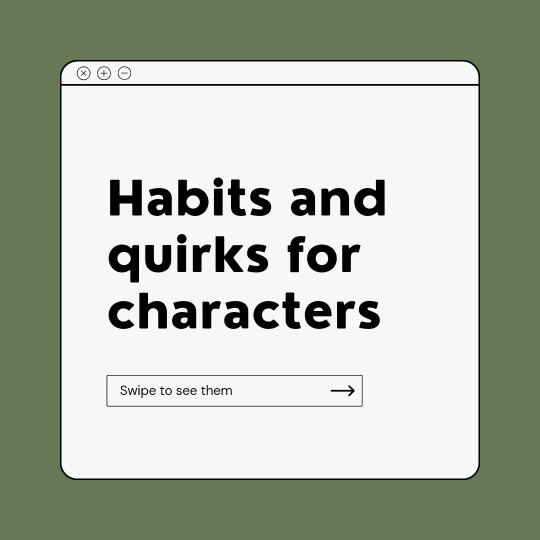

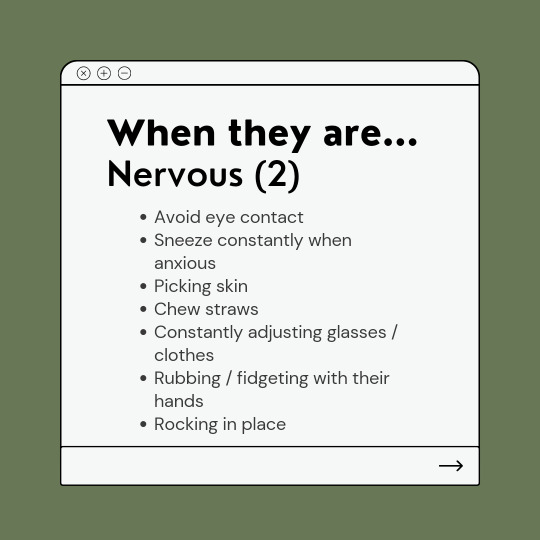
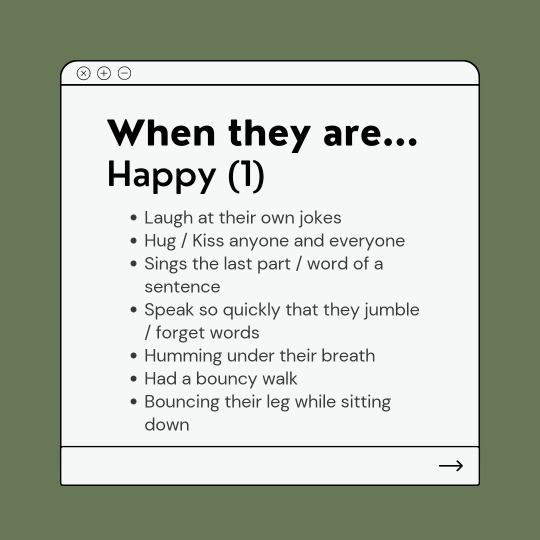

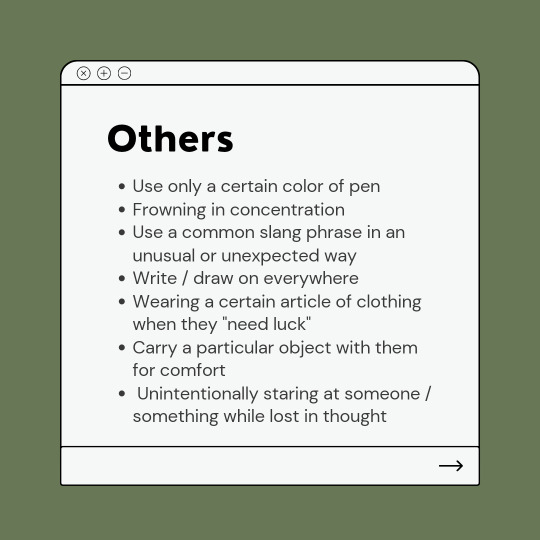
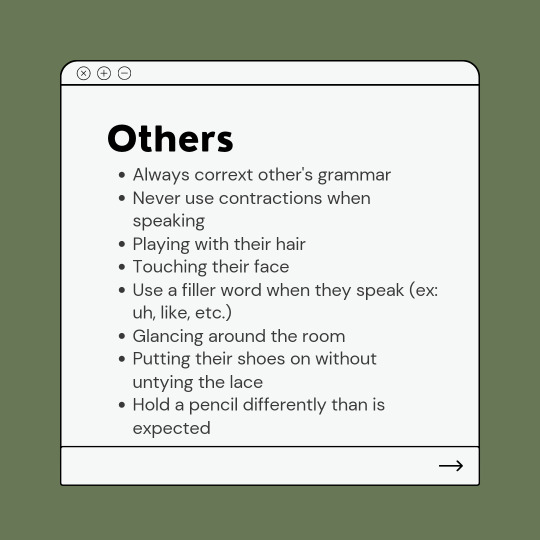
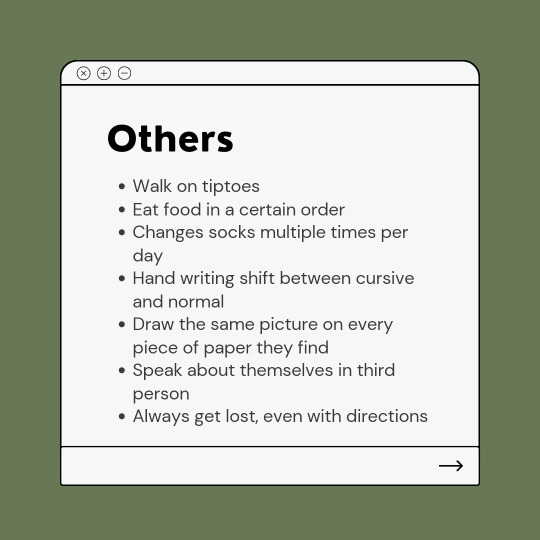
#writerscommunity#writers#writer things#writers on tumblr#writersociety#on writing#writblr#creative writing#writeblr#writing#writer#write#writings#writers and poets#female writers#writing stuff#writing a book#writing community#writing inspiration#writing ideas#writing prompt#writing advice#writer problems#fanfiction writer#writer stuff#writer community#writer on tumblr#women writers#writers block#ao3 writer
116 notes
·
View notes
Text
Character flaws
It's been a while since I wrote this post, so I'm a bit lazy to retype it.
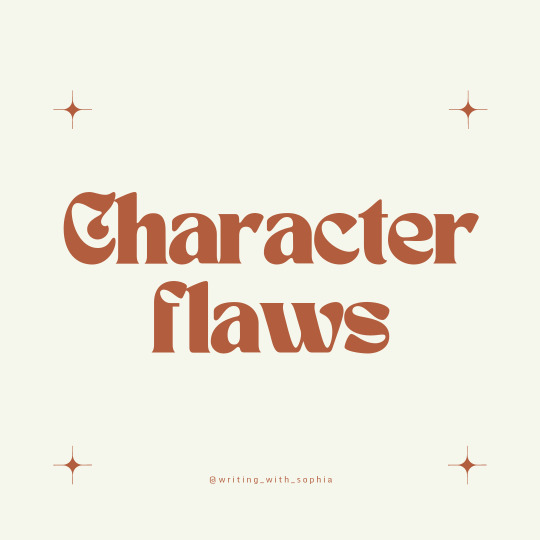
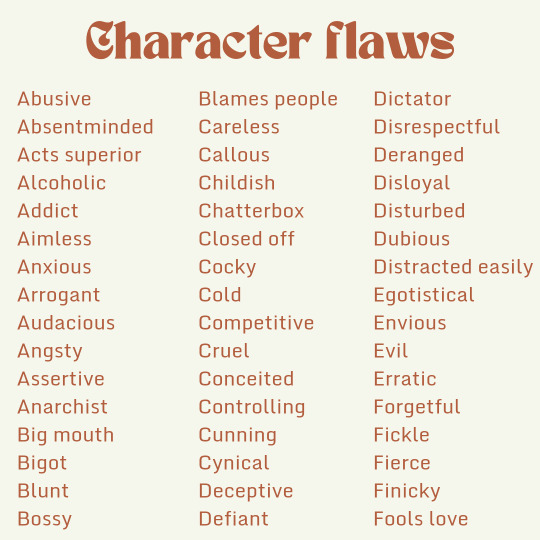
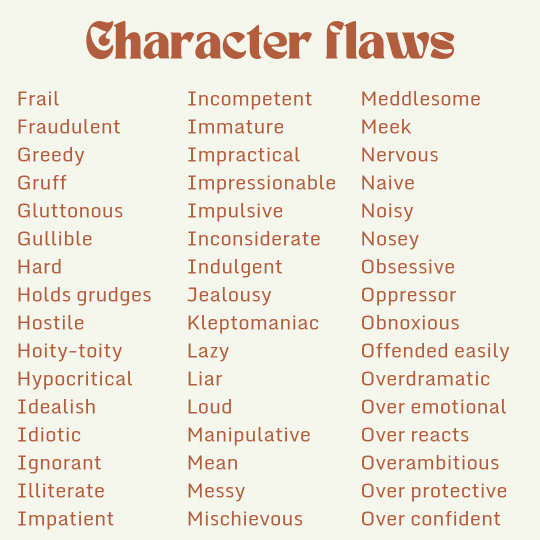
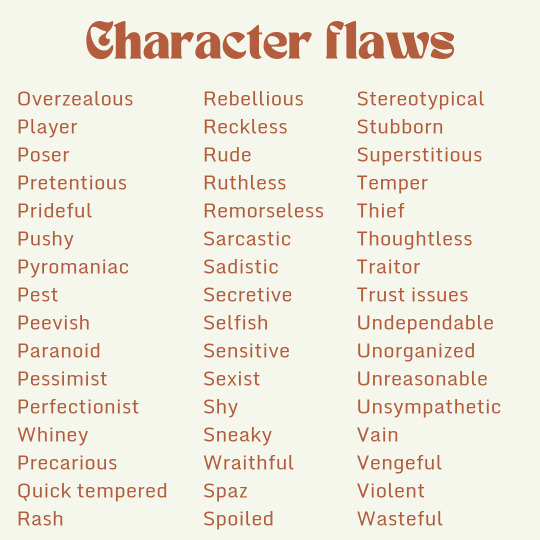
If you want to read more posts about writing, please click here and give me a follow!

1K notes
·
View notes
Text
Common misfortunes for characters
Death of a loved one: This can be a profound and devastating experience for a character, leading to grief, guilt, and a sense of loss. It can also serve as a catalyst for character development and exploration of themes such as mortality, coping with loss, and the fragility of life.
Serious illness or injury: Physical or mental health challenges can test a character's resilience and force them to confront their limitations. It can also provide opportunities for exploring themes of perseverance, the importance of support systems, and the fragility of the human body.
Loss of a job or financial ruin: Financial struggles can lead to desperation, uncertainty, and a loss of identity for a character. It can also present opportunities for growth, reinvention, and exploring themes of resilience, resourcefulness, and the true value of material possessions.
Betrayal by a trusted friend or ally: Betrayal can shatter trust and lead to feelings of anger, betrayal, and a loss of faith in others. It can create complex moral dilemmas for the character and explore themes of loyalty, forgiveness, and the dark side of human nature.
Imprisonment or wrongful accusation: Being imprisoned or falsely accused can lead to feelings of powerlessness, injustice, and a struggle for redemption. It provides opportunities for exploring themes of justice, personal agency, and the lengths one will go to prove their innocence.
Natural disasters: Natural disasters can be catastrophic events that disrupt lives, challenge survival instincts, and test a character's resilience. They can explore themes of human vulnerability, the power of nature, and the strength of community in times of crisis.
War or conflict: War and conflict can have profound impacts on characters, leading to physical and emotional trauma, loss of loved ones, and moral dilemmas. They provide opportunities for exploring themes of heroism, sacrifice, the futility of violence, and the long-lasting effects of war.
Addiction or substance abuse: Characters grappling with addiction or substance abuse can experience a downward spiral, strained relationships, and a loss of control. It allows for exploration of themes such as self-destructive behavior, the road to recovery, and the impact of addiction on oneself and others.
Mental health issues: Characters dealing with mental health issues like depression or anxiety can face internal struggles, isolation, and difficulties in functioning. It provides an opportunity to delve into themes of stigma, self-discovery, and the importance of mental health support.
Loss of a child or miscarriage: The loss of a child or experiencing a miscarriage can be emotionally devastating for characters, leading to grief, guilt, and questioning of one's purpose or identity. It allows for exploration of themes of parental love, coping with loss, and the complexities of grief.
Failed relationships or divorce: Characters going through failed relationships or divorce can experience heartbreak, loneliness, and a sense of failure. It presents an opportunity to explore themes of love, forgiveness, personal growth, and the complexities of human relationships.
Alienation or social isolation: Characters who feel alienated or socially isolated can grapple with feelings of loneliness, rejection, and a sense of not belonging. It allows for exploration of themes of identity, acceptance, and the importance of human connection.
Identity theft or fraud: Characters who fall victim to identity theft or fraud can face financial ruin, loss of reputation, and a struggle to reclaim their identity. It provides opportunities to delve into themes of trust, deception, and the lengths one goes to protect their identity.
Accidental injury or disability: Characters experiencing accidental injury or acquiring a disability can face physical and emotional challenges, adjusting to a new way of life, and overcoming societal barriers. It allows for exploration of themes such as resilience, self-acceptance, and the meaning of true strength.
Loss of a treasured possession or heirloom: Losing a treasured possession or heirloom can evoke feelings of loss, nostalgia, and a connection to the past. It provides an opportunity to explore themes of materialism, attachment, and the value of intangible memories.
Being stranded or lost in a remote or dangerous location: Characters finding themselves stranded or lost in a remote or dangerous location can face survival challenges, fear, and the need to rely on their instincts. It allows for exploration of themes of resilience, self-discovery, and the inherent strength of the human spirit.
Struggling with poverty or homelessness: Characters experiencing poverty or homelessness can encounter hardships, discrimination, and a constant struggle for basic needs. It provides an opportunity to explore themes of social inequality, resilience, and the power of compassion and empathy.
Encounter with a dangerous or malicious antagonist: Characters facing a dangerous or malicious antagonist can be subjected to physical and psychological harm, manipulation, and a fight for their lives. It allows for exploration of themes of good versus evil, moral choices, and the strength of the human spirit in the face of adversity.
Political or social persecution: Characters experiencing political or social persecution can face oppression, injustice, and the fight for their rights and freedom. It provides an opportunity to explore themes of social change, courage, and the power of collective action.
Being framed for a crime they didn't commit: Characters who are framed for a crime they didn't commit can face wrongful accusation, a loss of trust, and the pursuit of justice. It allows for exploration of themes of innocence, perseverance, and the search for truth.
These misfortunes can be used individually or combined to create layered and complex narratives where characters face adversity, overcome challenges, and ultimately find strength and growth through their experiences. Remember to balance the misfortunes with moments of resilience, hope, and eventual triumph to create a compelling narrative.
If you want to read more posts about writing, please click here and give me a follow!

#writer things#writers#writersociety#on writing#writerscommunity#writers on tumblr#writblr#write#writers and poets#female writers#ao3 writer#amwriting#writers block#authors#writer#writeblr#writing advice#writing asks#writing community#writing a book#resources#creative writing#writing#advice
3K notes
·
View notes
Note
How to write a good Anti-Hero? How to find the perfect balence, lay out a good personality + backstory?
I love your blog so much! Your suggestions are so helpful💕
Writing a good Anti-Hero
I'm glad that my blog can be of assistance to you! Here's a step-by-step guide to help you create a well-rounded anti-hero:
Identify Their Key Traits: Start by identifying the key traits and characteristics of your anti-hero. Consider what makes them different from a traditional hero and how those traits contribute to their complex nature. Are they cynical, charismatic, or morally ambiguous? List these traits to have a clear picture of who they are.
Develop a Compelling Backstory: Create a backstory that justifies the anti-hero's behavior and motivations. Their backstory should provide insight into their past experiences, traumas, or circumstances that shaped their worldview. Consider how their backstory influences their choices and drives their actions.
Establish Their Moral Code: Define the anti-hero's moral code and ethical boundaries. Anti-heroes often operate in shades of gray, so their moral code may be different from society's expectations. Determine what principles guide their actions and explore the conflicts that arise when their code clashes with societal norms.
Flaws and Vulnerabilities: Give your anti-hero flaws and vulnerabilities that make them relatable to readers. Flaws could include arrogance, a short temper, or a tendency to push people away. Vulnerabilities humanize the anti-hero and create opportunities for character growth and development.
Motivations and Goals: Clearly define the anti-hero's motivations and goals, which may be complex and multifaceted. Determine what drives them and what they seek to achieve. Their motivations can evolve throughout the story as they confront challenges and face personal revelations.
Create Conflicting Relationships: Develop relationships for your anti-hero that challenge their beliefs and motivations. These relationships can include allies, enemies, or ambiguous connections. Interactions with other characters can push the anti-hero to question their choices and evolve as a character.
Internal Conflict and Dilemmas: Explore the internal conflict your anti-hero experiences as they navigate their choices and actions. They may struggle with the consequences of their morally ambiguous behavior or question the validity of their goals. Internal conflict adds depth and complexity to their journey.
Moments of Empathy and Redemption: Provide moments of empathy and potential redemption for your anti-hero. Show glimpses of their capacity for goodness or selflessness, even if it's buried beneath their rough exterior. These moments can create emotional connections with readers and open the possibility for redemption arcs.
Growth and Change: Allow your anti-hero to experience growth and change throughout the story. This can involve challenging their beliefs, confronting their flaws, or reevaluating their moral code. Their journey should be transformative, leading to personal development and self-reflection. Remember to demonstrate your anti-hero's growth and transformation through their actions and choices. Instead of relying solely on internal monologues or self-reflection, emphasize how their behavior and decisions shift over time.
Avoid Excessive Villainy: While anti-heroes may engage in morally ambiguous actions, be cautious not to make them excessively villainous or unsympathetic. Give them redeeming qualities or justifications for their behavior to maintain reader interest and empathy.
Consistency and Complexity: Ensure consistency and complexity in your anti-hero's personality. They should feel like fully fleshed-out individuals with nuanced emotions, motivations, and reactions. Avoid one-dimensional portrayals and explore the various facets of their character.
Reader Engagement: Keep readers engaged by providing them with a window into the anti-hero's thoughts, emotions, and motivations. This can be achieved through introspection, dialogue, or interactions with other characters.
There are some questions to help you develop a well-rounded anti-hero with a balanced personality and backstory:
Personality:
What are the defining traits and characteristics of your anti-hero? How do these traits set them apart from traditional heroes?
How does your anti-hero interact with others? Are they charismatic, aloof, or manipulative?
What flaws does your anti-hero possess? How do these flaws contribute to their complexity and relatability?
What vulnerabilities does your anti-hero have? How do these vulnerabilities influence their behavior and choices?
How does your anti-hero handle conflict and adversity? Are they hot-headed, strategic, or unpredictable?
What defense mechanisms or coping mechanisms does your anti-hero employ to protect themselves emotionally?
How does your anti-hero's personality influence their relationships with other characters in the story?
Backstory:
What significant events or traumas from their past have shaped your anti-hero's worldview and motivations?
How do these past experiences contribute to their moral code and ethical boundaries?
Are there any formative relationships or connections in your anti-hero's backstory that have influenced their behavior?
What led your anti-hero to adopt their morally ambiguous or unconventional methods?
How does your anti-hero's backstory justify their motivations and goals?
Are there any unresolved conflicts or unfinished business from their past that drive their actions in the present?
How does your anti-hero's backstory create internal conflicts and dilemmas for them throughout the story?
Balancing the character:
How do you strike a balance between your anti-hero's morally ambiguous actions and their redeeming qualities?
What moments of empathy or vulnerability can you include to make your anti-hero relatable and sympathetic to readers?
How does the anti-hero's moral code and personal motivations create conflicts and challenges for them?
In what ways can you show the growth and evolution of your anti-hero's personality and beliefs over the course of the story?
How do the relationships and interactions with other characters challenge or influence your anti-hero's personality and choices?
What internal conflicts or dilemmas does your anti-hero face as they navigate their morally gray path?
How can you create opportunities for your anti-hero to question their actions, reflect on their choices, and potentially pursue redemption?
Remember, crafting a compelling anti-hero requires careful consideration of their traits, backstory, and journey. Aim for complexity, relatability, and a balance between their morally ambiguous actions and redeeming qualities. With thoughtfulness and depth, you can create an anti-hero that captivates readers and challenges traditional notions of heroism.
Additionally, if you need, you can find the post on villain redemption here.
If you want to read more posts about writing, please click here and give me a follow!

355 notes
·
View notes
Note
Miss Sophia, I have a question. Um, well first of all...
I actually like slice of life, fantasy, romance, horror, sci-fi.
But my question is... Ahem. How do you make romance scenes non cringy?
Becsaiw sometimes when I'm writing them, I cringe, and feel weird. Others, my my heart flutters.
How to make romantic scenes not cringe?
Well, honestly, for me, this question is so hard to answer... As my strength is romance, I can't give you any advice based on my experience. What I do when writing romantic scenes is simply… imagine and write. So, I searched the internet, read some articles and learned a few things. Hope it will help you.
Tip 1: Develop realistic and relatable characters

Ensure that your characters are well-rounded and have depth. Give them distinct personalities, flaws, and motivations that readers can connect with. This will make the romantic interactions more believable and engaging.
Tip 2: Show, don't tell

Instead of explicitly stating how characters feel, demonstrate their emotions through their actions, dialogue, and body language. How do they treat each other? How do they talk to each other? When one person is sick, what will the other person do? Are they shy or bold when meeting the person they love? The more details you tell, the more genuine the feelings between them will be.
Tip 3: Build emotional tension

Establish a strong foundation of emotional connection and chemistry between the characters. Develop their relationship gradually and create moments of anticipation and longing. This will make the romantic scenes more captivating and less cringe-worthy.
Tip 4: Prioritize consent and respect
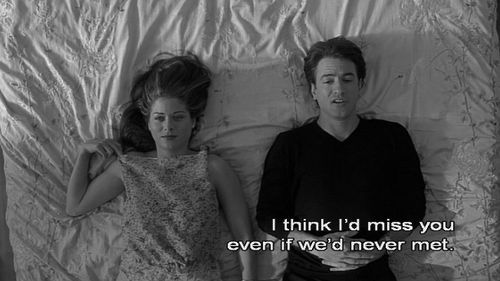
Ensure that the romantic interactions include clear communication, mutual respect, and consent. Avoid any scenes that may promote unhealthy dynamics or non-consensual actions, as they can easily become cringe-worthy or uncomfortable for readers.
Tip 5: Use subtlety and restraint

Sometimes, less is more. Avoid over-the-top gestures or exaggerated romantic dialogue that can feel forced or insincere. Instead, focus on small, genuine, and meaningful moments that allow readers to connect with the emotions being portrayed.
Tip 6: Balance romance with other elements

Incorporate other elements such as humor, conflict, or character development alongside the romantic scenes. This will add depth and prevent the story from becoming overly focused on romance, which can sometimes lead to cringe-worthy moments.
Tip 7: Read romance novels

You cannot write a beautiful love story without reading any romance novels, unless you write it based on your own story. You can read famous works like Pride and Prejudice, Jane Eyre, Red, White & Royal Blue, or anything else that interests you, and learn how the characters interact with each other. This is the best way.
That's all. Good luck!

91 notes
·
View notes
Text
Common character archetypes in literature
Character archetypes are universal patterns of behavior, personality traits, and motivations that are commonly found in literature, mythology, and other forms of storytelling. They are often used as a shorthand to help readers quickly understand and relate to a character's role and purpose in the story.
Here are some common character archetypes:
The Hero: The hero is a brave and noble character who goes on a quest or journey to achieve a goal or overcome a challenge. Examples of heroes include Odysseus in Homer's "The Odyssey" and Frodo in J.R.R. Tolkien's "The Lord of the Rings."
The Villain: The villain is an evil character who opposes the hero and tries to prevent them from achieving their goal. Examples of villains include Darth Vader in "Star Wars" and Iago in Shakespeare's "Othello."
The Mentor: The mentor is a knowledgeable and seasoned figure who directs and encourages the protagonist throughout their adventure. Examples of mentors include Gandalf in "The Lord of the Rings" and Obi-Wan Kenobi in "Star Wars."
The Trickster: The trickster is a mischievous character who uses their wit and cunning to achieve their goals. Examples of tricksters include Loki in Norse mythology and Hermes in Greek mythology.
The Damsel in Distress: The damsel in distress is a female character who requires saving from a hero. Examples of damsels in distress include Princess Peach in the Mario video game series and Sleeping Beauty in the fairy tale of the same name.
The Wise Old Man/ Woman: The wise old man or woman is commonly portrayed as having immense wisdom and expertise, and often acts as a mentor or guide to the protagonist. Examples of wise old men and women include Dumbledore in the Harry Potter series and the Oracle in Greek mythology. Such archetypes have been frequently employed in literature over time to communicate universal themes and concepts about human existence.
The Innocent: The innocent is a pure and uncorrupted character who often serves as a symbol of hope and goodness. Examples of innocents include Dorothy in "The Wizard of Oz" and Boo Radley in "To Kill a Mockingbird."
The Outcast: The outcast is a character who is rejected by society and often feels a sense of alienation or isolation. Examples of outcasts include Frankenstein's monster in Mary Shelley's "Frankenstein" and Hester Prynne in Nathaniel Hawthorne's "The Scarlet Letter."
The Temptress: The temptress is a seductive female character who lures men into danger or temptation. Examples of temptresses include Circe in Greek mythology and the character of Delilah in the Bible.
The Scapegoat: The scapegoat is a character who is blamed for the problems or issues of others. Examples of scapegoats include Tom Robinson in "To Kill a Mockingbird" and Piggy in "Lord of the Flies."
The Rebel: The rebel is a character who challenges authority and often advocates for change. Examples of rebels include Winston Smith in George Orwell's "1984" and Holden Caulfield in J.D. Salinger's "The Catcher in the Rye."
The Everyman: The everyman is a relatable character who represents the average person and often serves as the protagonist in a story. Examples of everymen include Bilbo Baggins in "The Hobbit" and Winston Smith in "1984."
The Wise Fool: The wise fool is often portrayed as someone who appears to be simple-minded, foolish, or even insane, but who possesses insights and wisdom that are not immediately apparent to others. Examples of the wise fools include the protagonist in "Diary of a Madman" and Yorick in "Tristram Shandy".
The preceding list outlines the typical character archetypes found in literature. Can you determine which archetype best fits your characters?
If you want to read more about The Wise Fool archetype, click here: The Wise Fool - Who is that?
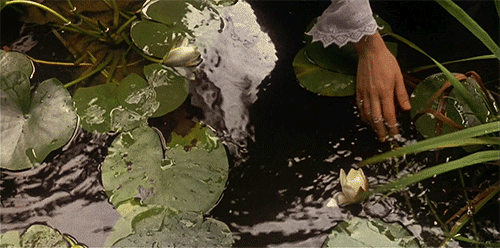
734 notes
·
View notes